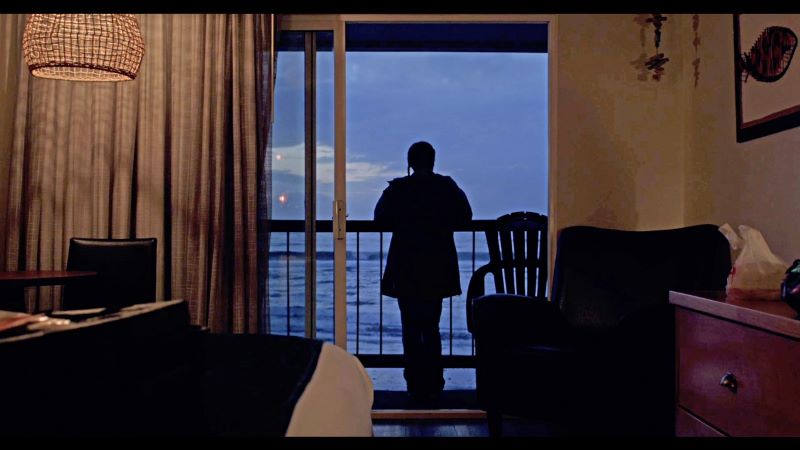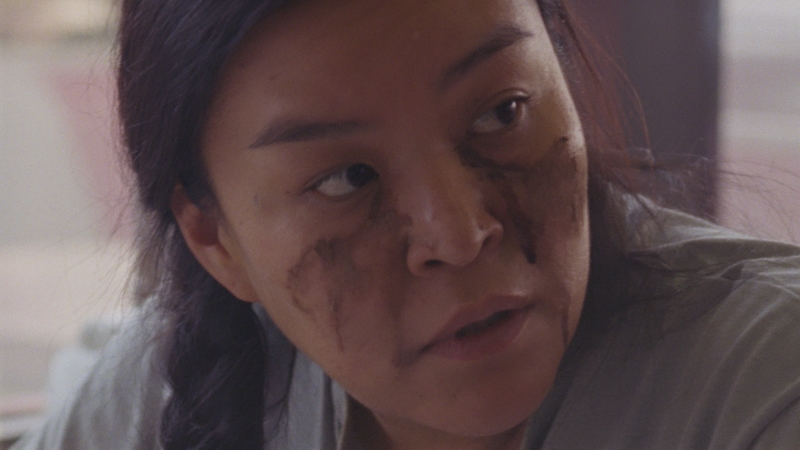Terms & Conditions: On Indigenous Cinema Within the United States
Terms & Conditions: On Indigenous Cinema Within the United States
By Adam Piron
In a war that lasted throughout 1872-1873, the small band of Modoc Indians and their leader Kintpuash fought outnumbered against the crushing machine of the Union Army. Yet the Northern Californian tribe won nearly every battle against the United States’ advances until their eventual surrender. This David and Goliath struggle quickly became a costly and embarrassing affair for the government. It was decided that a photographic glimpse from the front would be a strategic way to boost public morale. For this task the U.S. government employed a local renowned for his landscape photography and stereographic experimentation: Eadweard Muybridge.
On May 3, 1873, Muybridge arrived at the warzone near Yreka, California. Facing the technical complexities of photography at the time coupled with the hazards of a live battlefield, he settled for re-creating scenes through a series of staged tableaux, a common practice of contemporary war photography. Unable to capture the Modoc themselves for these re-creations, he took artistic license and lensed the army’s Indian Scouts in their stead. That they were from completely different tribes was of no importance. The necessity was just having images of Indigenous people in this narrative.
Muybridge’s work was published by a number of San Francisco’s newspapers, as well as Harper’s Weekly, all lauding his documentary efforts. After Kintpuash and his people surrendered, he along with three other Modoc leaders were sentenced to hang in October of that year, with the direct approval of President Ulysses S. Grant. After the executions, their heads were sent to the Army Medical Museum in Washington, D.C. and were later acquired by the Smithsonian.
Since its beginning, the United States of America has been at odds with legitimizing its own narrative and the complications of deciphering where and how to place Indigenous people in relation to it. Whether it’s been Muybridge’s Modoc War stereographs or Edison’s Buffalo Dance (1895), the desire to access an “authentic” Indigenous image, no matter the consequence, runs deep on this land. American Cinema and its precursors, like everything else in its country, were informed in part by an Indigenous presence, or at least a need for it. Because of Indigeneity’s unique history in relation and opposition to the colonial system of the United States, it seems that this was an inevitability.
Understanding this history is a first step to approaching all things Indigenous on their own terms and in their proper context. In the case of film and criticism in its current forms, that presents a unique set of considerations when engaging with an Indigenous Cinema and its essence. Identifying what Indigenous Cinema is and what it isn’t, as well as a familiarity with the history of controlling the Indigenous image, is key to qualifying it.
In the era directly after westward expansion, touring Wild West shows were a major attraction. Springing up in the latter half of the 1870s and hitting their peak in the following decade, they featured known personalities of the frontier, cowboy performers, bison, and Indigenous people. All of the latter were survivors of the recent Indian Wars, starving transplants from newly formed reservations with no other means of survival. Part of the marketing draw for white audiences seeing Indigenous people perform in this context was the last chance to see a “vanishing race,” an endangered species on its way out. As these exhibitions continued into the 1890s, their popularity waned and the format’s demise soon bled into the rise of a new form of entertainment: cinema. Many of the performers from these shows naturally found work in early films, especially as early westerns solidified as a popular genre. With this development, the need for Indigenous people onscreen became a constant. The 200 Lakota that lived in tipis on the premises of Inceville during the 1910s, solely as stock for Thomas H. Ince’s productions, is but one metric of the demand during this era.
The chances are high in a silent western that the Indigenous characters on screen were actually played by Indigenous people—a stark contrast from what would later become the norm. Many of these performers retired or returned to their homelands by the early 1920s, and non-Indigenous actors soon filled the void as the film industry rode a new boom in feature-length westerns. Soon after, a flattened iconography of Indigenous people developed and was baked into popular visual culture, largely devoid of any tribal specification. It became a costume for other performers to wear and appear in, what’s now known as redface. Indigenous people never had control over how they were represented in popular culture, but this was a key moment that found their own image wrested from themselves.
A similar trajectory of misappropriation followed in American non-fiction film. The documentary’s compulsion for salvage ethnography, a now widely critiqued practice of early American anthropology rooted in notions of capturing cultures before their assumed extinction, is at its most pronounced in Robert J. Flaherty’s Nanook of the North (1922). Despite its distinction as being the first ever feature-length documentary, the film has since been criticized for its subhuman portrayals of the Inuit in comparing them to animals and for its plethora of staged sequences inferring they were technologically a century behind how they were currently living. The success of Flaherty’s work further cemented American Cinema’s image of Indigenous people as living outside of modernity. Where the western objectified Indigeneity into myth, the documentary presented that myth as an objective truth for the white gaze.
Highlighting this chronology is meant to emphasize the cost of eroding the agency of Indigenous people over their own image. Like anything thrust into a dynamic against colonialism, the mechanics of Indigenous Cinema are ultimately defined by having control of that agency. In and of themselves, Indigenous representations do not equal an Indigenous Cinema. These histories are that of an American Cinema, which is something completely separate and a cinema by Indigenous filmmakers should not be approached as such. In many ways, Indigenous Cinema is a quality pertaining to a spectrum of work revolving around two defining axes. One is that an Indigenous person has direct authorship over what is and what isn’t on screen. The second is its prioritization and centering of an Indigenous audience. It’s something boldly by and for Indigenous peoples.
Barring the work of early Indigenous filmmakers, namely James Young Deer and Edwin Carewe, the idea behind an Indigenous-specific cinema within what is now known as the United States did not come about until the 1970s and later into the 1980s. Many of the defining works of this era were largely documentary, such as Chris Spotted Eagle’s Do Indians Shave? (1972) and Arlene Bowman’s Navajo Talking Picture (1985) or Victor Masayesva, Jr.’s Itam Hakim, Hopiit (1985), and were connected to the momentum of the American Indian Movement (A.I.M.) or born out of a reaction to the legacies of American Cinema’s misrepresentations of Indigenous people. As a cinema, this body of work was further defined in the 1990s and 2000s by the increase of narrative works such as Chris Eyre’s Smoke Signals (1998), Shelley Niro’s experimental hybrid feature Honey Moccasin (1998) and Blackhorse Lowe’s Shimasani (2009).
All of these generations of filmmakers and their work have in various ways set the stage for a recent blossoming in the past five years of work by a new generation of filmmakers. Films like Sky Hopinka’s maɬni – towards the ocean, towards the shore (2020), Shaandiin Tome’s Mud (Hashtł’ishnii) (2018), and Lyle Corbine Jr.’s Wild Indian (2021) point to an Indigenous Cinema that’s increasingly distinct and separate, intentionally and aesthetically, from the cinema of its colonial state.

Long before the American film industry looked West, the Los Angeles metropolitan area originally grew from the Tongva village of Yaangna. What would become L.A.’s downtown was built over it and the remnant of the village’s original center is now a small industrial acreage. An archival web clip within Fox Maxy’s Maat Means Land (2020), a rapid-fire collage of Californian Indigeneity and a recent recipient of IFFR’s Ammodo Tiger Short Award, spotlights this place’s particular significance. The excerpt sees Tongva elder L. Frank Manriques visiting this patch of land, reflecting: “This is our place and we know how to talk to it… and in that it’s in the doing or in the making that there’s the power.” It’s unavoidable, but so much of what distinguishes this cinema is its affirmation of Indigeneity’s tie to the land itself.
Beyond declarations of this fact, the tie manifests itself in a number of thematic approaches, most notably through employing Indigenous languages in various aspects of the film and a heavy focus on landscapes. A very literal example of this declaration can be seen in Tome’s Mud (Hashtł’ishnii). The lead character is a member of the Diné Mud Clan and their death at the finale is portrayed as an actual absorption into the land itself. As they disappear into the earth, their dying words are “Hashtł’ishnii,” which translates as “mud.” This shared cinematic concern bolsters its distinction from an American Cinema because it defines itself as something akin to a collective of national cinemas based on tribal affiliations.

This feeds into another notable feature within this recent wave of films: a characteristic emphasis on the nuance of tribal subjectivity over an authoritative stance on pan-Indian experiences. Filmmaker Sky Hopinka’s body of work is emblematic of this and specifically leans into his relationship with his own Indigeneity. When I asked him about this, he responded: “A lot of what I’ve been interested in doing in the last few years has been about exploring more specific aspects of my tribe and my culture in my beliefs and my friendships, and having my own subjectivity account for a lack of authority or account for the authority that is given to me by the person who is holding the camera and editing and making these choices.” It’s part of a larger assertion of these works that Indigenous Cinema does not represent a monolith of a single people or nation, but rather it acts as a blurred label of the work of artists hailing from distinct cultures connected largely by a shared historical struggle.
This perspective naturally lends itself to a kind of personal filmmaking encouraging experimentation, most notably by translating culturally specific perspectives and philosophies into new cinematic languages determinedly outside the traditions of an American Cinema. An example of this can be seen in Adam and Zack Khalil’s INAATE/SE/ (2016) and its structure modeled after The Seven Fires Prophecy of the Ojibwey. It’s an approach that criticism in its current forms categorizes as avant-garde, which in a sense it is, but that label also denotes a miscategorization and deferment of Indigenous film within the framework of an American Cinema. It’s a fundamentally colonial and flawed way to read such work by situating it at the margins of convention as an unusual object. It’s imperative for critics to understand this difference and to recognize that these artists are members of sovereign groups separate from what is now known as the United States, in both a political and cultural sense.
Because of this, there’s a disorientation or lack of awareness within mainstream criticism of how to approach these films. When I spoke with Lyle Mitchell Corbine, Jr., the director behind Wild Indian, he reflected on the critical response to his film after its premiere at this year’s edition of the Sundance Film Festival. “They have a hard time, I suppose, just being outsiders recognizing what it is and for who it is. In Wild Indian’s case, it’s a movie made for other Indians. It’s not really made for non-native people in a way to attract them.” Shea Vassar, a film critic and citizen of the Cherokee Nation of Oklahoma, describes this issue in this way: “[I]t kind of misses the mark, where you have a lot of mostly white men who are reviewing these films and almost every time they miss some major cultural aspects of the film. When you have a film like Wild Indian that is so nuanced and you don’t know the basic histories behind what the filmmaker is trying to say, how are you supposed to review that film accurately?” This state of affairs is also partly a matter of numbers: writers at larger publications with a cultural vantage point like Vassar’s are few and far between. In the colonial state as it stands, why would publications driven to be on the better side of aggregated popular opinion and clicks bother digesting an art form made for less than two percent of the population?
Their loss is ultimately the gain of the more art-minded corner of criticism today. Writers at publications such as Hyperallergic, Artforum, Film Comment (RIP), Cinema Scope, MUBI Notebook, and The Brooklyn Rail have a stronger history of and aptitude for considering these works on their own aesthetic merit, ultimately less concerned with determining what popular box they fit in. Outside of screenings in their home communities or Indigenous film festivals, these films largely live and die on the festival and museum circuit, but much of the added travel and attention given to these films as of late has been as a result of praise through this type of criticism. The recognition has aided the advancement of a space within the film and art worlds for Indigenous filmmakers and further validated the cinematic value of these films beyond their intended audience. This form of criticism may not necessarily be concerned with or even aware of the differences between Indigenous Cinema and American Cinema. But the response has been added leverage for Indigenous filmmakers and their own cinema to continue and increasingly be met on its own terms and on a global stage.
